目录
5 60 本教材点评
5.11 数论 5 本
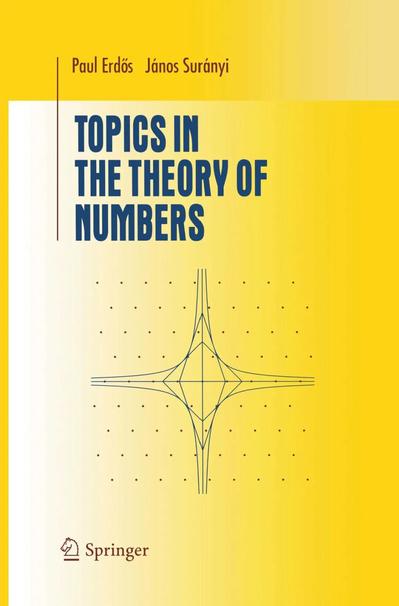
《Topics in the Theory of Numbers》
作者:P. Erdős
出版商:Springer
出版年:2003
ISBN:9780387953205
适用范围:高年级本科生,研究生
推荐强度:9
作者简介: P. Erdős(著名数学家,匈牙利籍犹太人,发表论文达1475篇,为现时发表论文第二多的数学家,第一是欧拉。其研究领域广泛,诸多定理和猜想以他命名)
书评:
This Springer publication is the English translation of the second edition of Erdös and Surányi’s 1959 book. The second edition came out in 1995, with some new chapters and updated results. This translation, done by Barry Guikuli, with some assistance by Romy Varga, was completed in 2000, four years after the death of Paul Erdös. If you don’t know who Erdös is, check out The Man Who Loved Only Numbers or My Brain in Open. (And if you are a mathematician who doesn’t know who Paul Erdös is..., well, shame on you!)
As the (less-than-descriptive) title suggests, this book deals with number theory, or more specifically, several subareas of number theory, which I detail below. The purpose of the book is to present some of the relatively recent results in these different areas, and to highlight some of the results of Erdös. However, even though some fairly advanced results are presented, the authors don’t take much for granted: each topic is built, for the most part, from basic principles. The reader is then taken on a whirlwind tour of the advanced results.
The first section in the book is a brief statement of ten facts that are used in this book, without proof. The facts are standard results from combinatorics and analysis, things like the binomial theorem, or the fact that log x grows slower than any positive power of x. (Actually, I wish more texts did this.)
Chapter 1 covers Divisibility, the Fundamental Theorem of Number Theory. As the title suggests, we’re starting from first principles. The authors give the Remainder Theorem (aka the Division Algorithm) followed by a set of problems. Many of the usual basic properties of divisibility are proven, although not always in the standard way. The authors make use of the Four Number Theorem:
If a and b are positive numbers and c and d are positive integers such that ab = cd, then there exists a positive number r and positive integers s, t, and u such that the following equalities hold: a = rs, b = tu, c = rt, d = su. If, in addition, a and c are integers, then r may be taken to be an integer.
The proof presented is a geometric argument. (In fact, the authors use geometry quite a bit in this book.) From this theorem, we get many divisibility results, including prime factorization and the Fundamental Theorem of Arithmetic (which is what it’s called in the text, despite the name of the chapter). We also get results about the least common multiple, prime factorization of factorials, a complete description of Pythagorean triples, sums of two squares, the Euclidean algorithm, and the two-variable linear Diophantine equation. As mentioned before, most of this is standard elementary number theory.
Chapter 2 (which was added to the second edition of the book) deals with Congruences. Once again, we start from first principles. Some basic properties of congruences are derived, including divisibility rules for 9 and 11, and the notion of residue classes modulo m. The authors then mention the ideas of disjoint and covering systems of congruences. Some examples are given, along with the current state of affairs. For example, we are told that covering systems with smallest modulus 3, 4, 6, 8, 9, and 20 exist, the names of mathematicians who created them, and that
We do not know whether for an arbitrary m0 there exists such a covering system with smallest modulus m0. To date, we do not even know the answer for all m0 less than 20, nor do we know whether there exists a covering system for which every modulus is odd.
In the exercises following this section, the reader is told to prove that for a covering system, the sum of the reciprocals of the moduli is at least one. Keep in mind, this is a mere eight pages after the introduction of the definition of congruence! The authors’ goal seems to be to make a beeline from the basic principles to the current state of affairs. Not a problem if you’re an experienced mathematician, but probably not something you would want to subject an undergraduate to. We are then given results about solutions to linear congruences and the Chinese Remainder Theorem. Then we get a proof about reclusive primes:
For any given number N, there exists a prime number that is at least N greater than the previous prime number and at least N smaller than the following one.
The proof makes clever use of the Chinese Remainder Theorem, and Dirichlet’s theorem on primes in an arithmetic progression (a proof of this is not given, just a reference). There is some discussion of the Euler phi function, including Fermat’s Little Theorem and Euler’s Theorem. The authors use Euler’s Theorem to show how the RSA encryption scheme works (although they do this without even mentioning RSA or the names Rivest, Shamir, and Adleman). The remainder of the chapter involves standard material: residue classes, polynomial congruences, Wilson’s Theorem, the Legendre symbol, and quadratic reciprocity.
Chapter 3, titled Rational and Irrational Numbers. Approximation of Numbers by Rational Numbers (Diophantine Approximation), deals with Diophantine Approximation (which would have been a better title). Once again, we start out slow, dealing with the decimal expansion of a real number, and how that expansion might tell us about whether the number is rational or irrational. The irrationality of the square root of m2 + 1 for any integer m is established using a geometric argument. A trigonometric series is used to prove that tan(π/m) is irrational for all integers m larger than 4. And the series for e is used to show that e is irrational. Some results on transcendental numbers are given, and the chapter closes with a summary of some of the work (no proofs included) of Roth, Thue, Siegel, Mahler, Baker, and others.
Chapter 4 deals with Geometric Methods in Number Theory. The authors discuss lattices and the notion of parallelogram lattices. They give the standard result about what kind of polygons can occur in a parallelogram lattice, as well as some properties of lattices, including Pick’s Theorem and Minkowski’s Theorem. The properties are then used to establish results involving Diophantine Approximation and sums of squares (similar to Burger’s chapters on the Geometry of Numbers in Exploring the Number Jungle). The chapter closes with a study of inhomogeneous lattices and divided cells.
Chapter 5 deals with Properties of Prime Numbers. The chapter begins with a summary (no proofs) of some results concerning the difference between consecutive primes. The authors give a proof that the sum of the reciprocals of the primes diverges. They also prove Chebyshev’s result for the π(x) function (which counts the number of primes less than or equal to x). They next prove Bertrand’s Conjecture (that there always exists a prime between n and 2n). Some mention is made concerning the history of the Prime Number Theorem. Once again Dirichlet’s theorem on primes in an arithmetic sequence is mentioned, and the authors supply proofs for special cases of Dirichlet’s theorem.
Chapter 6 covers Sequences of Integers. The authors use the Euclidean algorithm to introduce the Fibonacci sequence. They then discuss the idea of the upper and lower density of a sequence. The remainder of the chapter deals with some of the ideas in additive number theory:
• How to partition the first N integers into r sets so that no two numbers and their difference occur in the same set;
• The finite version of Fermat’s Last Theorem;
• Erdös and Turan’s discovery of the fact that however we chose 2k + 1 distinct positive integers, if we take all pairwise sums, then at least k + 1 primes occur as prime divisors of these numbers (along with some recent variations of this theorem);
• The notion of M-sequences (sequences in which no member is a multiple of another);
• The notion of T-sequences (sequences which do not contain arithmetic progressions of length 3);
• The notion of Sidon sequences (sequences of nonnegative integers with the property that all pairwise sums of elements are distinct).
As before, some fairly advanced results are proven, but all deduced from basic principles.
Chapter 7 delves back into Diophantine Problems. A general solution is given for the Pythagorean n-tuple problem (x12 + x22 + ... + xn2 = yn) . The standard results concerning sums of squares (when is n a sum of two squares, a sum of three squares, or a sum of four squares) are proven. The authors then turn to higher powers, mentioning Waring’s problem, and the values of g(k) (the smallest number of kth powers needed to represent every positive integer), G(k) (the number of kth powers needed to represent every large enough positive integer and such that there are infinitely many integers which can not be expressed using less than G(k) kth powers), and w(k) (the smallest number of kth powers needed to represent every positive integer by adding and subtracting kth powers). The chapter ends with an exploration on whether binomial coefficients can be perfect powers, with some related results.
Chapter 8 returns to the topic of Arithmetic Functions. We get a probabilistic argument for the equation of the Euler phi function. This is followed by some results on the sigma function, including the notion of Mersenne primes, and perfect, abundant, and deficient numbers. This includes proofs of Euclid’s classification of the even perfect numbers, and the fact that for any s, there are at most finitely many odd perfect numbers with exactly s distinct prime factors. Many advanced results concerning the arithmetic functions mentioned above are proven, along with the two omega functions (which count the number of distinct primes dividing n, and the sum of the powers of the distinct primes dividing n). The remainder of this chapter gets into some fairly heavy analysis.
Following the last chapter, there is a section with hints to some of the more difficult problems in the exercises. (One note of caution: the hints to problems 31 and 32 of Chapter 8 are labeled as 30 and 31.)
The only negative thing I would say about the book involves the presentation. The sections in each chapter are numbered 1, 2, 3, etc, but the authors don’t start each new section on a new page or even with a title. When section 1 ends, it is immediately followed by either a set of problems or by section 2. The sections aren’t given titles, although in the Table of Contents, a description of each section is given. It might have been beneficial to the reader to place this description at the beginning of the section. (In fact, the layout of each chapter, presented in the Table of Contents, is a better guide than the text itself.) It seems that the authors, however, want the prose to flow from one section to the next, without any interruption (except for the occasional problem set). Another concern is the fact that the problems are numbered the same way (1, 2, 3, etc). Each set of problems is clearly labeled with Exercises, and each problem is indented, so there is some difference between how the sections and exercises are presented. But it is somewhat subtle. All things considered, these are relatively minor flaws (presumably not the kind of presentation which is to be found in The Book).
This book is part of the Undergraduate Texts in Mathematics series, but that may be stretching the term undergraduate. If you are interested in any of the topics listed above, you’ll almost certainly enjoy this book. If you’re not a big fan of number theory (assuming such people exist!), then you won’t find much here to enjoy.
这一Springer出版社的版本是Erdös和Surányi的著作第二版的英译本。第二版出版于1995年,新增了一些章节,更新了一些结论。在Romy Varga的帮助下,Barry Guikuli于2000年完成了对此书的翻译,距Paul Erdös逝世已有四年。如果你没听说过Erdös,那么去看看The Man Who Loved Only Numbers或是My Brain in Open吧(如果你是一位数学家但却不知道Paul Erdös是谁的话…这简直太丢人了)。
就如同书名所述,本书是有关数论的,或者更具体地说,有关一些数论的子领域,我将在下文详细说明。本书的目的是介绍这些不同领域的一些相对较新的成果,并强调 Erdös 的一些成果。然而,尽管本书给出了一些相当好的结果,但作者并不认为它们是空穴来风:每个主题在很大程度上都是从基本原理逐渐构建的。掌握基础知识后,读者将有机会领略这些更深层次结论的魅力。
这本书的第一部分是对书中使用的十个事实的简短陈述,没有证明。这些事实是组合学和分析学的一般性结论,比如二项式定理,或者logx的增长速度比x的任何正幂都慢(事实上,我希望有更多的教材可以这样做)。
第1章“可约,数论的基础”。正如标题所示,我们从最基本的公理开始。作者给出了余数定理(又称除法算法)和一组习题。许多常见的与可约有关的性质都被证明,虽然证明方法不那么标准。比如四数定理:
“如果a与b是正数且c与d是正整数使得ab=cd,那么就存在一个正数r与正整数s, t
与u使得下列等式成立:a=rs, b=tu, c=rt, d=su. 特别地,如果a与c也是整数,那么r也可以取为整数。”
书中的证明使用了几何方法。(实际上,作者在本书中很少使用几何方法)。从这个定理出发,我们得到了许多与可约相关的结论,包括素数分解与算数基本定理(这只是它的名字,与章节名无关)。我们也得到一些有关最小公倍数、素因子分解、勾股定理、两数平方和、辗转相除法与两元Diophantine方程的结论。就像之前提到的,这些内容中的大多数都是标准基础数论的内容。
第2章(在本书的第二版添加)“同余”。我们再次从最基本的公理开始。我们可以推导出一些有关同余的性质,包括对9与11的可约原则和模m余数类的概念。作者随后提到了覆盖同余式的思想。书中列出了一些实例来帮助读者理解。例如,本书告诉我们存在最小系数为3,4,6,8,9,20的覆盖同余式,介绍了创造它们的数学家,并且:
“我们不知道对于任意的m0来说,是否存在以m0为最小系数的覆盖同余式组。直至今日,我们甚至不知道m0小于20的全部情形的答案,同时我们也不知道是否存在一个所有系数都为奇数的覆盖同余式组。”
在这节的练习中,读者被要求证明对于一个覆盖同余式组,所有系数的倒数和至少为一。记住,这仅仅在介绍同余定义的8页后。作者的目标似乎是从最基本的原理到目前最新的研究进展修建一条笔直的大道。如果你是一个有经验的数学家,这不是问题,但这可能并不是你想让本科生学习的东西。本书随后给出了与线性同余的解相关的结论和中国剩余定理。随后我们得到了有关“隐藏素数”的证明:
“对任给的N,存在一个素数使得它至少比小于它的最大素数大N,同时比大于它的最小素数大N.”
证明巧妙地在一个算数级数中的素数上使用了中国剩余定理与Dirichlet定理。(证明并没有直接给出,但被列于参考文献中)。本书还讨论了Euler函数,包括Fermat小定理与Euler定理。作者用Euler定理来表明RSA加密方案的工作原理(虽然这部分甚至没有提到RSA或是那些名字Rivest,Shamir与Adleman)。本章的其余部分包括了标准的内容:余数类、多项式同余,Wilson定理,Legendre符号和二次互反律。
第3章“有理数与无理数,数的有理数估计(Diophantine估计)”,处理Diophantine估计(可能会是个更好的标题)。如同以往,我们在开篇部分放慢脚步,处理一个实数的小数展开,并且讨论其小数展开是如何告诉我们它是有理数还是无理数的。的平方根的无理性基于一种几何方法。本章也应用三角级数来证明tan(π/m)对所有比4大的整数m都是无理的,同时也应用e的级数展开来证明e是无理数。最后此章给出了一些有关超越数的结论,并以Roth, Thue, Siegel, Mahler, Baker等数学家的工作结束。
第4章“数论中的几何方法”。作者讨论了格与平行四边形格的概念,给出了一般性的结论来描述平行四边形格中可能出现的何种多边形,并给出了格的一些性质,包括Pick定理和Minkowski定理。随后,作者利用这些性质来建立包含Diophantine近似与平方和的结果(类似于Burger的Geometry of Numbers in Exploring the Number Jungle)。本章最后研究了非均匀晶格和分裂单元。
第5章“素数的性质”。本章首先总结了一些有关连续素数间的差的结论(无证明)。证明了素数的倒数和是发散的。作者也证明了切比雪夫有关π(x)函数的结论(计算小于等于x的素数)。接下来本章证明了Bertrand的猜想(在n与2n之间总是存在一个素数),并对素数定理的历史作了一些介绍,最后本章再次提出了有关连续素数的Dirichlet定理,并对Dirichlet定理的特例给出了证明。
第6章“整数数列”。作者利用Euclidean算法引入Fibonacci数列,随后讨论了数列的上密度与下密度的概念。本章的其余部分将讨论堆垒数论中的一些想法:
如何将前N个整数划分成r个集合,使同一集合中不出现两个数及其差;
Fermat大定理的有限情形;
Erdös和Turan发现任何2k+1个不同的正整数,如果我们取它们的两两之和,那么至少k+1个素数作为这些数的素因子出现(以及这个定理最近的一些变形);
M数列的概念(任何一项都不是另一项的倍数的数列);
T数列的概念(不包含长度为3的等差子列的数列);
Sidon序列的概念(任意两项之和都两两不同的非负整数序列);
和之前相同,本章证明了一些相当深入的结论,但都是从基本原理推导出来的。
第7章“Diophantine问题”。本章给出了n元Pythagorean问题(n个元素的平方和为y)的一般解,证明了关于平方和的一般性结论。随后作者转向高次方,提到了Waring的问题与函数g(k)(能将每个正整数表示为k次方和所需的元素个数的下界,例如g(2)=4, 即任意正整数可以被表示为4个整数的平方和),G(k)(能将足够大的正整数表示为G(k)个k次方和,且存在无穷多个正整数不能被表示为小于G(k)个k次方和)与w(k)(能将每个正整数表示为k次方和或差所需的元素个数的下界)。本章最后探讨了二项式系数是否可以是完全幂,并给出了一些相关的结论。
第8章“数论函数”。本章首先引入了一个Euler phi函数方程的概率参数,接着讨论关于sigma函数的一些结论,包括Mersenne素数的概念、完全数、充数与亏数。这包括Euclid对偶数完美数分类的证明,以及对于任何s,至多有有限多个奇完美数具有恰好s个不同素因子的事实。本章证明了许多有关上述算术函数,包括两个Ω函数(计算n不同素因子个数与n不同素因子的幂次的和)的深入的结论。本章的其余部分将进行一些相当复杂的分析。
在最后一章之后,有专门一节来提示习题中一些较难的问题(注意:第8章问题31和32的提示被误标为30和31)。
关于这本书,我认为它唯一的缺点就是表述。每一章中的章节编号为1、2、3……,但作者进入下一节时并没有新启一页,甚至没有新的标题。当第一节结束时,紧接着是一组问题或第二节。这些节没有标题,尽管在目录给出了有关每节的描述。将此描述放在本节开头可能对读者有所帮助(事实上,在目录中呈现的每一章的布局都比教材本身更好)。然而,作者似乎希望内容连续排布,而没有任何中断(除了偶尔的习题集)。另一个问题是习题的编号方式相同(1、2、3……)。每一组习题都清楚地标明了“习题”,而且每一题都有首行缩进,因此正文和练习的呈现方式有所不同,这有点奇怪。总地来说,这些都是相对较小的缺陷。
这本书是Undergraduate Texts in Mathematics系列的一本,但可能需要较长时间来学习。如果你对上面列出的任何内容感兴趣,你几乎肯定会喜欢这本书。如果你不是数论的忠实粉丝(假设存在这样的人!),那你在这里就找不到什么可以享受的了。
点评人:Donald L. Vestal(南达科他州立大学数学系助理教授,主要研究领域是数论、组合数学)
资料整理:冯远航
翻译:赵旭彤
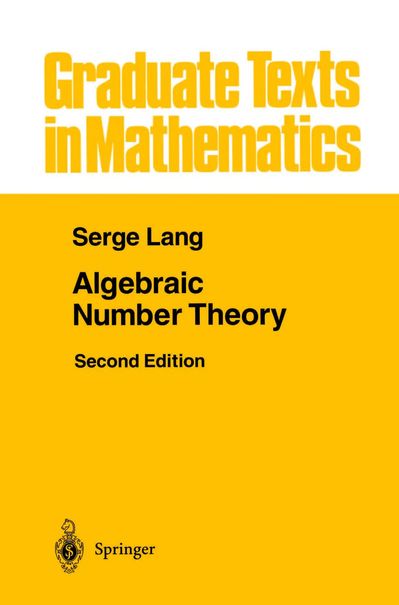
《Algebraic Number Theory》
作者:Serge·Lang
出版商:Springer
出版年:2000
ISBN:9780387942254
适用范围:高年级本科生,研究生
推荐强度:10
作者简介: Serge·Lang (1927-2005,法裔美国数学家、活动家,在耶鲁大学任教多年。他以数论方面的成就和他的数学教科书闻名,包括颇具影响力的《Algebra》。1960年,他获得弗兰克·尼尔森·科尔奖,是波旁派的一员。)
书评:
Algebraic number theory has an unparalleled pedigree. Its prehistory sports none other than Fermat and Euler: just think of Fermat’s Last Theorem and the Law of Quadratic Reciprocity, which Euler knew but never explicitly proved. I believe that a proof can be glued together from results Euler had at his disposal, to be sure, but the first complete proof is credited to Gauss --- who then gave six more. Gauss, with his famous Disquitiones Arithmeticae, is likely the one to be credited with giving the greatest impetus to what eventually became this algebraic theory of numbers as a Ding in Sich; certainly, the subject, while still not autonomously defined, took off spectacularly in his wake. Indeed we encounter a host of players throughout the later 19th century, including Eisenstein, Sophie Germain, Dedekind, Dirichlet, Kummer, Kronecker, and so on: I am sure I am missing some obvious others. However, it is undeniable that by the end of that century, this discipline was ready for a proper definition, and it was Hilbert’s famous Zahlbericht that did the job.
Of course, Hilbert did a great deal more than collect and present the known number theoretic material surrounding algebraic numbers, i.e. roots of polynomials with integer coefficients. For one thing, he gave a very far-reaching extension of Kronecker’s work leading to modern class field theory. For another, Hilbert gave the definitive treatment of reciprocity laws, going well beyond the quadratic one (Gauss-Euler), covering all degrees and all algebraic base fields. So the stage was set: in proper order algebraic number theory could be taught as a well-defined university course, and texts began to emerge. These included what André Weil characterized in his Basic Number Theory as the premier source for this material given in classical language, namely, Vorlesungen über die Theorie der algebraischen Zahlkörper, or Lectures on the Theory of Algebraic Number Fields, by Hilbert’s student Erich Hecke. In any case, the game was afoot, and many authors began to contribute their own versions of the subject, including Hermann Weyl, Emil Artin, and Helmut Hasse. As the 20th century marched on and research on this and allied parts of number theory intensified and expanded, other books appeared. Many of these are now considered standards, e.g. the aforementioned book by Weil, in which idèles and adèles are featured with gusto; the pedagogical masterpiece, Number Theory, by Borevich and Shafarevich; and of course the Brighton Conference Proceedings, a.k.a. Algebraic Number Theory, by Cassels and Fröhlich. Each and every one of these books is in its own way fabulous and vital for the number theorist to learn his craft, and it is in this collection that we should fit the book under review.
What most distinguishes the many books by Serge Lang is their specific focus on teaching the indicated subject to the prepared student. In this aspect, they are probably unsurpassed as excellent sources for serious courses in a modern doctoral program: Lang intended them for specifically that purpose, and this is certainly the case for Algebraic Number Theory. In contrast with, e.g., Borevich-Shafarevich, Cassels-Fröhlich, and Weil, Lang occupies a very different place. Borevich-Shafarevich is a masterpiece, but it cuts a much broader swath than Lang’s book, and requires the reader to develop other themes, whose roles are initially unclear to the novice. The reader should have some experience with algebraic number theory already before he opens this book. Cassels-Fröhlich is encyclopedic, terse and authoritative; every number theorist should have a copy (and read it, study it, and annotate it), but it’s not the place to start --- Lang’s book, on the other hand, is. And this contrast is even more stark when we take a look at another masterpiece, Weil’s Basic Number Theory. In fact, this truly marvelous book, by a true grandmaster of the theory of numbers, simply should not be touched unless the reader has already served a serious apprenticeship. I love Weil’s work, but it would be terribly disingenuous to suggest that it is accessible to any but the seriously initiated. Basic Number Theory is basic only in that what Weil develops in its pages is vital for modern research in algebraic number theory; it is also a beautifully written book, elegant and concise in the manner associated with Weil --- but it is certainly not for the beginner. That beginner would do well to start with Lang’s book.
All right, then, how does one define “beginner” in this context? What should a rookie aspiring number theorist know before going at Lang’s book, or taking a graduate course that uses this book? I would say that the standard first-year graduate course in algebra (groups, rings, fields, vector spaces: Lang’s Algebra is an excellent source) is non-negotiable, and it would be beneficial if said rookie had some exposure to commutative algebra (say, via Atiyah-MacDonald, Introduction to Commutative Algebra). Otherwise, it’s probably optimal to get one’s first exposure to the beautiful and standard fare of the subject straight from Lang’s very well-crafted book.
Caveat: to Lang’s credit, and as a testimony to the fact that Lang was properly influenced by developments in number theory that were set into motion by such mathematicians as Artin, Tate, and Weil, the book under review covers, in part one, idèles and adèles. These are very important topics, indeed, but are a bit austere; to get at these, it would be useful if the reader were to have a pretty solid grounding in point set topology, if only at the undergraduate level.
It is obvious that Lang’ Algebraic Number Theory is a very well written and important book: a major player in the sweepstakes for which book to use to learn this sub-discipline well --- very well. It comes very highly recommended.
代数数论有着无与伦比的家系。它的开创者不是别人,正是Fermat和Euler:只要想想Fermat大定理,以及二次互反律,Euler对此十分了解,但从来没有完整地证明。毋庸置疑,由Euler的一些结论可以拼凑出一个证明,但是第一个给出完整证明的是Gauss,随后他又给出了六种不同的证明。Gauss(著有Disquitiones Arithmeticae)很可能是为代数数论发展为如今的体系做出最大贡献的人。当然,虽然代数数论在那是还没有被定义,但在Gauss之后这个领域蓬勃发展起来。实际上,我们会遇到很多19世纪后半叶的数学家,包括Eisenstein, Sophie Germain, Dedekind, Dirichlet, Kummer, Kronecker等人:我不敢保证没有遗漏一些伟人。然而,不可否认的是,至19世纪末,已经有关于这门学科恰当的定义,正是由Hilbert的著作Zahlbericht给出。当然,Hilbert所做的远远不止是收集并展示有关代数数(即整系数多项式的根)的已有资料。一方面,他将Kronecker的工作进行了非常深远的推广,开拓了现代类域论。另一方面,希尔伯特细致研究了互反律,范围远远超出了二次互反律(Gauss-Euler),涵盖了所有的度和所有的代数基域。因此,在这个时期人们有了共识:在按恰当的顺序的前提下,代数数论可以作为一门大学课程被讲授,相关教材开始出现。它们包括André Weil在他的Basic Number Theory中作为主要参考材料的Vorlesungen über die Theorie der algebraischen Zahlkörper或者说Lectures on the Theory of Algebraic Number Fields,由Hilbert的学生Erich Hecke编写。无论如何,代数数论的研究仍在继续,其他数学家也开始为这个领域做出自己的贡献,包括Hermann Weyl, Emil Artin与Helmut Hasse. 随着20世纪数学的发展,对这一理论及其相关内容的研究不断加强和拓展,其他书籍开始出现。其中许多在现在被认为是相当经典的教材,例如上述Weil的书;Borevich与Shafarevich的著作Number Theory;以及Cassels与Fröhlich的Brighton Conference Proceedings, 又名Algebraic Number Theory. 这些书中的每一本都有其独到之处,对数论研究者来说,学习这些独到的技巧是至关重要的。
Serge Lang的书与其他教材的不同之处在于,它特别注重向已有预备知识学生来教授知识。在这方面,它对一个该领域的博士生来说是绝佳的参考资料:Lang专门以这个目的来编写此书,而代数数论就是如此。与Borevich, Shafarevich, Cassels, Fröhlich和Weil等人不同,Lang的教材在诸多代数数论书籍中十分独特。Borevich与Shafarevich的书是一本杰作,但它比Lang的书涉及的范围要广得多,并且要求读者研究其他内容,数论的初学者可能不太容易弄清这些内容。读者在翻开它之前应该已经有了一些代数数论的基础。Cassels与Fröhlich的书则是百科全书式的,简洁却又严谨;每个研究数论的学者都应当有一本(细读并研究它),但它也不是一本入门教材——然而Lang的书却不同。当我们看另一部杰作,Weil的Basic Number Theory时,这种对比就更加明显了。事实上,这本确确实实的杰作,是一位真正的数论大师写的,除非读者已经接受了系统性的训练,否则根本不应该碰它。我喜欢Weil的作品,但如果说除了那些真正的学者,任何人都能读懂它,那就太没有诚意了。Basic Number Theory是“Basic”的,只是因为Weil在书中所写的东西对现代代数数论的研究是至关重要的。它也是一本写得很漂亮的书,优雅而简洁——但它肯定不是为初学者准备的。初学者最好从Lang的书开始。
好吧,那么,在这种情况下,如何定义“初学者”?一个初出茅庐的有抱负的数论研究者在读Lang的书之前,或者上一门使用这本书的研究生课程之前,应该知道些什么?我想说的是,毋庸置疑研究生一年级代数(群,环,域,向量空间:Lang的Algebra是一个很好的参考文献)课程是必须的,接触交换代数(例如,Atiyah与MacDonald的Introduction to Commutative Algebra)很有帮助。否则,最好从Lang的精雕细琢的书中直接领略这一内容的魅力。
注意:值得称赞的是,Lang的书受到了数论发展的影响,尤其是Artin, Tate与Weil等数学家的工作。这些的确是非常重要的内容,但有些难懂;要了解这些,如果读者在点集拓扑学方面有一个相当扎实的基础,即使只是在本科水平上,那也将是非常有用的。
很明显,Lang的Algebraic Number Theory是一本写得很好而且很重要的书:在众多代数数论教材中也是佼佼者——十分优秀。我非常推荐这本书。
点评人:Michael Berg(美国加州洛约拉马利蒙特大学数学系教授)
资料整理:冯远航
翻译:赵旭彤
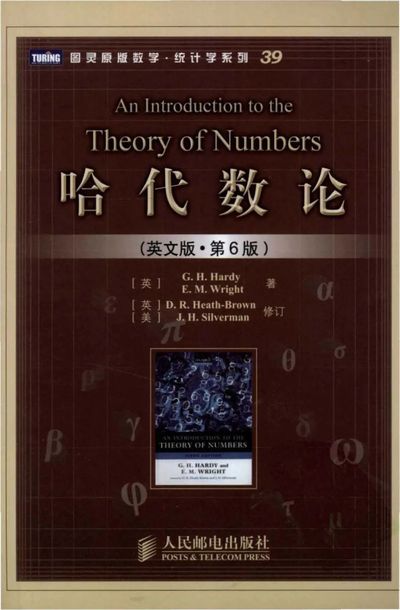
《An Introduction to the Theory of Numbers》
作者:G.H. Hardy,E.M. Wright
出版商:Oxford University Press
出版年:2008
ISBN:9780199219865
适用范围:本科生
推荐强度:9
作者简介: G.H. Hardy(1877-1947,世界最伟大的数学家之一,他的数学贡献涉及解析数论、调和分析、函数论等方面。他一生著述颇丰,计有8部专业书籍和大约350篇论文。1936年,我国著名数学家华罗庚被维纳推荐给哈代,惜才的哈代对华罗庚极为赏识,哈代还挖掘了拉马努金等数学天才。)
E.M. Wright (1906-2005,和他在牛津大学的导师哈代合写《数论介绍》An Introduction to the Theory of Numbers以著名的英国数学家。29岁时,Wright开始在亚伯丁大学任数学教授。第二次世界大战后,渐加入大学行政架构,1961年任副校长,1962年任校长及名誉副校长,至1976年退休。)
书评:
This 6th edition is a modest update to the 1979 5th edition, which was itself a modest update to the 1960 4th edition, so we're essentially dealing with a new publication of a 50-year old book. It's still a wonderful book, and well worth buying if you don't already have a copy. It even has an index now!
The book has been completely re-typeset for this edition, giving it a more attractive look, with more white space and with more of the formulas displayed. But the typesetting introduced an alarming number of typographical errors: I counted 23 typos in this first printing, some serious, and I wasn't even looking very hard.
The body of each chapter is essentially unchanged, except for the correction of some typos in the 5th edition and some footnotes pointing out now-inaccurate statements or obsolete terminology. The chapter endnotes have been expanded, updating progress since the last edition. There is a completely new chapter (by Joseph Silverman) on Elliptic Curves. Although this is well done, it has a very different character from the rest of the book: it is a survey, proving some results but quoting many. The rest of the book is narrowly focused: If it quotes a result, it proves it (with few exceptions).
Hardy & Wright is a good example of Mark Twain's definition of a classic: A book which people praise and don't read. It's worthwhile to summarize some of the more unusual items included: construction of the regular 17-gon, proof of the transcendence of π and e, the Lucas-Lehmer test for primality of Mersenne numbers, Bertrand's postulate (actually a theorem: between every number and its double is a prime), and a complete elementary proof of the Prime Number Theorem. The discussion of orders of magnitude of arithmetical functions is very thorough, covering average, normal, minimal, and maximal orders of most common arithmetic functions (another good book for that subject, that goes into even more depth, is Gerald Tenenbaum's An Introduction to Analytic and Probabilistic Number Theory). The exposition is very clear, and the proofs have just the right amount of detail: concise, but not too concise to follow. The chapters on continued fractions and on algebraic numbers, two notoriously confusing subjects, are especially clear.
It's also worth comparing Hardy & Wright (here abbreviated HW) against another heavyweight in the introductory number theory textbook arena: Niven, Zuckerman, and Montgomery's An Introduction to the Theory of Numbers (abbreviated here as NZM). This book is itself 18 years old (the 5th edition was in 1991) but in many ways it is much more modern than Hardy & Wright. The most conspicuous difference is that HW has no exercises; it is that peculiar thing, an introductory textbook aimed at mathematicians. NZM is packed densely with exercises and is clearly aimed at undergraduates. HW is deep rather than broad; it ignores many topics of elementary number theory, but goes into great detail on the ones it tackles. NZM has coverage of some newer topics not covered in HW, for example Schnirelmann density, factorization methods, and public key cryptography. NZM also covers some older topics omitted from HW, such as quadratic forms and looking at some number theory theorems as special cases of abstract algebra theorems.
此版第6版只是在1979年第5版的基础上做了小幅修改,而第5版本身也只是对1960年第4版做了小幅修改,所以我们基本上只是新出版了一本50年前的书。但它仍然是一本很棒的书,如果你还没有一本的话,买一本是很值的。这版中甚至有了索引!
此版内容经过了重新编排,使其看起来更吸引人,包括更多的空白部分与公式。但是重新排版带来了大量的排版错误:我在此版的第一次印刷中发现了23个排版错误,有些很严重,而我甚至并未仔细审阅。
除了对第5版中的某些排版错误与一些脚注中不准确的陈述或过时术语的更正外,每一章的正文基本上没有变化。本版新增了关于椭圆曲线的一章(Joseph Silverman著)。虽然此章写得很好,但它有一个与书中其他章节非常不同的特点:它是一个研究调查,证明一些结论,但却也未经证明地引用了许多他人的结论。本书的其余部分则更加集中与深入:如果引用了一个结论,它的证明也会给出(除了少数例外)。
Hardy与Wright的书很好地诠释了Mark Twain对“经典之作”的定义:人人都称赞却不愿去读的书。其中一些不寻常的结论是值得总结的,它们包括:正17边形的构造,证明π与e是超越数,梅森数素性的Lucas-Lehmer检验,Bertrand的假设(实际上是一个定理:在每个数和它的两倍之间存在一个素数),以及素数定理的一个完备的初等证明。本书关于数论函数的阶的讨论非常深入,涵盖了常见的数论函数的平均、正规、最小和最大阶(Gerald Tenenbaum的An Introduction to Analytic and Probabilistic Number Theory更加深入地讨论了这一内容)。本书的叙述非常清楚,证明的细节也恰到好处:细致,但不过于细致。关于连分数和代数数的章节,这两个众所周知的不易理解的内容,也被解释得特别清楚。
在众多数论入门教材中值得与Hardy与Wright的书(这里缩写为HW)相比较的另一本重量级教材是Niven、Zuckerman与Montgomery的An Introduction to the Theory of Numbers(这里缩写为NZM)。这本书本身已经有18年的历史了(第5版是在1991年),但在许多方面它比HW要更贴近现代数学研究。最显著的区别是HW没有习题,它是一本专门针对数学研究者的入门教材。NZM有大量的练习,显然它是针对本科生的。HW内容深入却欠缺广度,它忽略了初等数论的许多内容,但却对它所涉及的内容进行了详细的阐述。NZM则涵盖了HW中未涉及的一些新兴的研究内容,例如Schnirelmann密度、因子分解方法和公钥密码术。NZM还涵盖了HW中省略的一些经典内容,例如二次型和把一些数论定理看作抽象代数定理的特例。
点评人:Allen Stenger(数学爱好者,MathNerds.com数学网站作者,退休图书馆员,研究兴趣为数论和经典数学分析)
资料整理:冯远航
翻译:赵旭彤
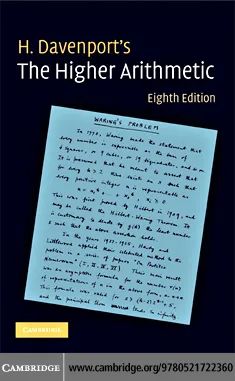
《The Higher Arithmetic》
作者:Harold·Davenport
出版商:Cambridge University Press
出版年:1992
ISBN:9780521422277
适用范围:本科生
推荐强度:10
作者简介:Harold·Davenport(1907-1969),英国数学家,著名的数论专家,毕业于曼切斯特大学和剑桥大学圣三一学院。他曾在多所著名大学任教,1957年至1959年,担任伦敦数学协会主席,1958年任剑桥大学劳斯•鲍尔教席。其在几何数论,丢番图逼近和解析数论领域做出了杰出贡献,曾获英国伦敦皇家学会西尔维斯特奖章。
书评:
Harold Davenport (1907–1969) was a British mathematician who worked in many areas of number theory. He wrote this book in 1952 as an introduction to number theory for a general audience. It has expanded over the years, and recent editions have been edited and added to by his son, James H. Davenport, a computer scientist at the University of Bath. The prerequisites have been kept very low: just high-school algebra and no calculus (but you do need a strong grasp of the algebra).
This is not a theorem-proof book. It’s more like a good expository talk, where you hear about the problems, see some examples, and then look at some statements of facts (results) along with arguments or explanations why they are true. There are in fact a lot of theorems and proofs here, but they are not packaged as such.
The chapter on continued fractions is especially good. It creeps up on the subject gradually, starting with fractions and the Euclidean algorithm, and lots of examples, but developing the algorithms in more generality than this. Then it makes the leap to irrational numbers (infinite continued fractions), concentrating on the case of quadratic irrationals (this case is especially nice because the fractions are periodic). It also goes into a good bit of detail about the approximation properties of the convergents. I believe this is the only part of the book that uses limits or infinite processes, although the way it is developed you don’t really have to understand those to follow the narrative.
There’s a lengthly and mostly up-to-date chapter on computers and number theory, that concentrates on several factorization methods and has a very clear section on cryptography with a good introduction (not just jumping directly to the Diffie-Hellman and RSA algorithms).
This eighth edition, published in 2008, is very polished. It has a support website with four pages of notes on new developments since publication, although it hasn’t been updated since 2013.
The market for this book is a little uncertain today. Originally it was aimed at the intelligent general reader who had a good knowledge of high-school mathematics, but I think there aren’t very many general readers today with a strong enough knowledge of algebra to follow the narrative. Most introductory number theory courses today are upper-division undergraduate courses and they are proofs courses, so this would not work well as a text. I do think it would work well as enrichment material; bright high-school math students would certainly be able to follow the book and many would be fascinated by it. It could also work for pre-service teachers.
There are a large number of short introductory number theory books at about the same level, most of which are more traditional textbooks than this one. Good examples of these include Vinogradov’s Elements of Number Theory, Dudley’s two books Elementary Number Theory and A Guide to Elementary Number Theory, LeVeque’s Fundamentals of Number Theory, and Andrews’s Number Theory. Some other books at the same level and with the same prerequisites as the present book, that also take an informal and exploratory approach, include Burn’s A Pathway into Number Theory (very IBL-oriented), Ore’s Number Theory and its History (lots of examples, almost no prerequisites), and Ogilvy & Anderson’s Excursions in Number Theory (a 1966 book that was also intended for a general audience but is probably too advanced today).
Harold Davenport(1907-1969)是英国数学家,在与数论相关的各个领域从事相关的研究。他在1952年写了这本书,以给一般读者提供一本数论入门教材。这些年来,它的内容不断充实,他的儿子James H. Davenport,巴斯大学的计算机科学家,也为最新版做了编辑工作并添加了一些新内容。本书所需的预备知识只有最低限度:高中代数学知识,并不需要微积分(但你确实需要对代数有很深入的理解)。
这不是一本只是证明定理书。读这本书更像是在与一位数学家对话,在那里你听到问题,看到一些例子,然后看看一些事实(结果)的陈述,以及断言或解释来说明为什么它们正确。事实上,这里有很多定理和证明,但它们并不像一般教材那样被给出。
关于连分数的章节很棒。它循序渐进地讨论这一内容,从分数和Euclid算法,以及大量的例子开始,进而发展出适用性更广的算法。然后,它跳至无理数(无限连分数),专注于二次无理数的情形(这种情形是很好的,因为分数是周期性的)。它还详细介绍了收敛的逼近性质。我相信这是书中唯一使用极限或无限过程的部分,尽管你并不需要真正理解极限就能跟得上教材的叙述。
有一章是关于计算机和数论的,很长而且大部分内容与前沿相关,集中在几种因子分解的方法上,并且有一节是关于密码学的,非常清晰地介绍了相关内容(不仅仅是Diffie-Hellman与RSA算法)。
2008年出版的第8版非常精美。它有一个配套的网站,上面有四页关于自出版以来新修订的说明,尽管这个网站自2013年以来一直没有更新。
今天这本书的市场有点不确定。最初它面向有良好中学数学基础的普通读者,但我认为当今没有多少普通读者有扎实的代数基础来跟得上教材的叙述。如今大多数的数论入门课程都是高年级的本科课程,而且都是专注于定理证明的课程,所以将它看作一本教材有点勉强。但我确实认为它是很好的拓展阅读材料;聪明的高中生肯定能看懂这本书,很多人会被它所吸引。它也适用于还未正式讲授课程的教师。
在同一水平上有大量的简明数论入门教材,其中大部分都是较传统的教材,包括Vinogradov的Elements of Number Theory, Dudley的两本书Elementary Number Theory与A Guide to Elementary Number Theory, LeVeque的Fundamentals of Number Theory和Andrews的Number Theory。有其他一些书籍,难度与本书相似,需要相同水平的预备知识,采取了非正式和探索性的叙述方式,包括Burn的A Pathway into Number Theory、Ore的Number Theory and its History(很多例子,几乎不需要预备知识),以及Ogilvy和Anderson的Excursions in Number Theory(1966年出版的一本书,也是为当时的普通读者准备的,但对如今的读者可能有些深奥)。
点评人:Allen Stenger(《密苏里数学杂志》编辑)
资料整理:冯远航
翻译:赵旭彤
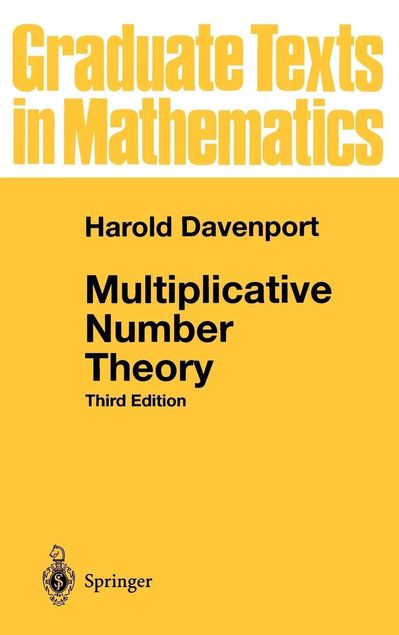
《Multiplicative Number Theory》
作者:Harold·Davenport
出版商:Springer
出版年:2000
ISBN:9780387950976
适用范围:高年级本科生,研究生
推荐强度:9
作者简介:Harold·Davenport(1907-1969),英国数学家,著名的数论专家,毕业于曼切斯特大学和剑桥大学圣三一学院。他曾在多所著名大学任教,1957年至1959年,担任伦敦数学协会主席,1958年任剑桥大学劳斯•鲍尔教席。其在几何数论,丢番图逼近和解析数论领域做出了杰出贡献,曾获英国伦敦皇家学会西尔维斯特奖章。
书评:
Number theory has two main branches: additive and multiplicative. Additive number theory studies expressing an integer as the sum of integers in a set; two classical problems in this area are the Goldbach conjecture (about writing even numbers as sums of two primes) and Waring's problem (about writing numbers as sums of n-th powers). Multiplicative number theory deals with prime numbers and related topics, such as factorization and divisors; a key result in this area is Prime Number Theorem. The book under review is one of the most important references in the multiplicative number theory, as its title mentions exactly.
The central topic of book is the distribution of primes, mainly in arithmetic progressions. In general, the author tries to follow the matter historically; as he mentions, the story goes back to Dirichlet's memoir of 1837 on the existence of infinitely many primes in arithmetic progressions, which is birth date of the Analytic Number Theory. Then, we have Riemann's full-effect memoir in the path, which suggested the main lines of investigation in the area. Finally, the author gives some important improvements and concludes the book by introducing some important and challenging problems for further studies. Thus, Davenport's book covers most of the important topics in the theory of distribution of primes and leads the reader to serious research topics, such as approximating the least prime in an arithmetic progression.
The book is very well written. It takes an analytic view of the subject; one may start reading it after having a course in elementary number theory and another course in complex variables and functions. Of course, a little knowledge of algebra (for understanding the nature of characters) is required.
This book is useful for graduate students, researchers and for professors. It is a very good text source specially for graduate levels, but even is fruitful for undergraduates. However, all of 29 sections of the book have no exercises, but students and professors can find many self-discovering homeworks hidden in the heart of its text. In the other hand, a large part of analytic number theory deals with multiplicative problems, and consequently most of its problem books contain exercises in multiplicative number theory; a suitable such problem book is Murty’s “Problems in Analytic Number Theory”.
As I see, the path of most investigations in the theory of distribution of primes derived from the body of this book; like a node on the tree of distribution of primes, which connects classical strong root to modern huge branches. The book understands what exactly is important and what is not. In comparision, there is no other book like it except people who have followed it.
The version under review is third edition and has been revised with both great expertise and care by Hugh L. Montgomery. According to the preface, sections 23-29 were completely rewritten.
数论有两个主要分支:加法和乘法。加法数论研究把一个整数表示为一个集合中整数的和的问题;这方面的两个经典问题是Goldbach猜想(关于把偶数写成两个素数的和)和Waring问题(关于把数写成n次幂和)。乘法数论处理素数及其相关的内容,如分解和因数;这方面的一个关键结果是素数定理。这本书是乘法数论中最重要的参考文献之一,正如书名所说的那样。
本书的核心主题是素数的分布,主要讨论等差数列的情形。总的来说,作者试图历史性地来看待这个问题;正如他所提到的,这个故事可以追溯到Dirichlet 1837年的回忆录,关于等差数列中无限多素数的存在性,这是解析数论诞生的日期。然后,我们有了在此领域有重大影响的Riemann的回忆录,其中提出了在该领域的主要研究方法与方向。最后,作者提出了一些改进意见,并对本书进行了总结,提出了一些值得进一步研究的问题。因此,Davenport的书涵盖了素数分布理论中的大部分重要内容,并引导读者深入研究某一主题,例如在等差数列中逼近最小的素数。
这本书写得很好。它从分析的角度看待这个问题;读者可以在上了初等数论和复变函数的课程后开始阅读。当然,需要一点代数知识(为了理解一些符号的本质)。
这本书对研究生、数学研究者和授课教师都很有用。对研究生,甚至是对优秀的本科生,它都是一个非常好的参考文献。然而,这本书的29个章节都没有习题,但是学生和教授们可以在书的核心找到许多问题以自行研究。另一方面,解析数论的很大一部分涉及乘法问题,因此此领域大部分习题集中都包含与乘法数论有关的习题;Murty的Problems in Analytic Number Theory是一本合适的习题集。
如我所见,素数分布理论中大多数研究的方法都能在本书中找到参照;它就像素数分布理论这棵树上的一个节点,连接着“古典数论”的根和“现代数论”的叶。这本书明白什么是重要的,什么是不重要的。相比之下,没有任何一本书能像它一样,除了那些依照它而编写的教材。
书评的版本是第三版,并已由Hugh L. Montgomery严谨而细致地修订过。根据序言,第23-29节被完全重写。
点评人:Mehdi Hassani(波尔多第一大学及伊朗赞詹基础科学高级研究所联合培养数学博士)
资料整理:冯远航
翻译:赵旭彤
